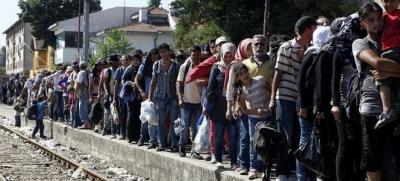Italian town introduces separate buses for refugees

SAVONA -- In the comune of Calizzano, a town of 1,545 inhabitants, to which over the past two years, 40 refugees have arrived, the mayor has introduced separate buses for locals and immigrants, the municipality said Thursday.
Monday morning in Calizzano, 6:15 am, on the first bus of the day that goes to the city, it feels as if one is transported to Lagos, in Nigeria, ‘Il Fatto Quotidiano’ writes. This bus is for the black people -- the bus 15 minutes later is for the white.
The 6:15 bus contains “14 Africans and a handful of Italians. Or, if you wish, it seemed as if one were in 50s America where the young black Rosa Parks was fighting to be able to travel on white people’s buses,” wrote ‘Il Fatto’ journalist, Ferruccio Sansa.
According to the mayor of Calizzano, Pierangelo Olivieri, “We need separate buses for the refugees.” But the reality, on visitng the small town, is different -- not just black and white. “Maybe a solution could be found without separating residents from migrants,” said Marco to ‘Il Fatto,’ a student who every morning still gets on this now infamous bus.
This village of 1,545 inhabitants is one that, like so many around this area, risks being emptied out and losing its identity. For work and for study, one has to go elsewhere -- it risks being turned into just a sleeping place.
Over the last two years, 40 refugees have arrived at the village, and have been put up in the Lux Hotel, managed by the cooperative 'Il Faggio.' They make up two percent of the population, but in Liguria Entroterra, the percentage of older residents is very high -- the average age of the inhabitants is about 50 -- and the presence of the refugees stands out more than in other places. Perhaps it sparks more fear.
“Up until now everything worked well. In fact, the new arrivals were integrated. There are about 10 refugees who carry out volunteer work in the commune. The football team coach is a migrant,” said Marco.
Everything seemed to be going smoothly up until Saturday evening when a fight broke out between two migrants from Ivory Coast and some Nigerians in the accommodation centre. It ended with the arrival of the Carabinieri police and an ambulance.
The fight was not particularly dramatic and no local residents were involved, but it seemed to ignite fear in the community. “We have done everything to integrate the migrants, but now the climate has changed, Mayor Olivieri said to ‘Secolo XIX.’ The mayor is a lawyer in his 40s who had previously refused to celebrate gay unions, saying that he is “first and foremost Catholic.”
“Yes, the atmosphere on the bus is not nice. The odd few inappropriate words, there are those who throw indecent glances at the girls. But overall, we are squished together like animals and everything exasperates us,” continued Marco.
A man who works closely with the migrants also added -- “believe me, up until now everything worked well. In fact, these guys brought a bit of life to Calizzano. But one should not try to hide the problems as well -- however great and disciplined they are, they are still young. And put 40 youngsters together, all male… The point is not that they are African, but that they are 20 years old. They need to meet people, they need life! A solution, however, can be found without introducing separate buses.”
Calizzano’s mayor denies any accusations of racism or intolerance, just talks about the overcrowding of buses. However, Danilo Pisano, president of the cooperative, does not agree -- “this idea is worthy of the worst apartheid state.”
Marco, the student who gets on the migrant bus every morning, shared his wise words with ‘Il Fatto’ -- “When there is unease, you always risk scapegoating. Refugees are perfect for this. People here are not intolerant, let us not make them racist. Let us rather resolve the problems -- we need more buses early in the morning. Race does not come into it, it is a question of money and reliability. We can find a solution.”
nkd


